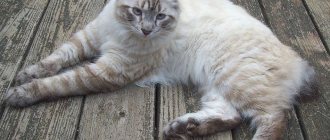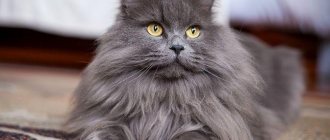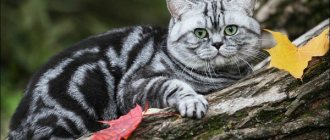The domesticated Serval is an extremely interesting and entertaining breed. These graceful creatures are one of the few cat families that belong to the wild. This explains their magnificent exotic color, non-standard habits and character traits.
They cannot be compared with ordinary cats, since servals require significant financial and time investments, careful study of the characteristics of the breed and a fairly serious approach.
Their owners are people with an exceptional love for cats and a desire to make friends with a reliable pet, which is quite capable of not only giving love to the owner, but also, if necessary, even protecting from danger.
The only thing is that when choosing a kitten, you need to contact trusted breeders and not skimp on your future furry friend.
History of the origin of the breed
The domestic serval is valuable because in appearance it looks exactly like a wild cat. Yes, in fact, he is a wild cat who decided to live in a nice mansion for a while. The homeland of the Serval cat is Africa. On the hot continent, their population, which was initially fairly large, has declined in recent years due to the fact that the beautiful fur of this cat attracts poachers.
Today there are 14 species of wild servals, which vary in coat color. Not long ago, breeders found out that the breed is perfectly domesticated (if you approach the matter wisely).
This is how domestic servals appeared.
You may also like the article about the Bengal cat.
Mistress of impressive animals
While I was admiringly looking at the living predator, a young, beautiful girl quietly approached me. She introduced herself in a pleasant voice: “I am Anna: the director of the Serval_family pet store, and part-time, the owner of charming creatures named Stephanie and Toby...”.
The owner and the cats were so remarkably similar to each other that I couldn’t resist showering them with compliments... Then I asked them to share with my readers the main secrets of raising African beauties.
Description of the Serval breed
The domestic Serval, as a proud representative of the “black” continent, gave his fans the opportunity to admire his African grace and predatory appearance. Yes, he is a predator, and his entire appearance is created in order to hunt and attack. The breed standard has not yet been fully developed, but some features have been recorded by nature itself.
- Serval kittens have a small head. But the ears, in comparison with the rest of the body, are large and set high, well-furred from the inside, on the outside they are covered with black and white stripes:
- the nose and bridge of the nose are wide;
- eyes almond-shaped below and boomerang-shaped along the upper eyelid;
- The pads under the vibrissae are pronounced, the vibrissae are obligatory, they are dense and long.
- The body size of the serval is small. Especially when compared with other wild cats in Africa. But compared to the usual domestic pussies, serval kittens are giants. Their body length can reach a meter.
The tail is thick and short (25-40 cm).
These cats are top models. Their limbs are the longest among all cats (in proportion to the body), the hind legs are longer than the front.
The listed differences are obvious, but this is not the entire list of the serval’s features. The weight of the “kids” is from 8 to 18 kg.
- The description of the serval's coat is similar to that of the cheetah. The animal is covered with spectacular spots that merge into stripes on the back. White coloring is visible on the chest, belly and muzzle. The color of the fur itself can be varied, ranging from sandy to reddish-brown.
The fur itself is short, unusually soft, thick and shiny.
Character
Servals are cats with character! And so that this character does not manifest itself in all its glory, it is necessary to as correctly as possible not allow the pet to show signs of wild ancestors.
African beauties love to play and run. Let them do both.
Since in nature they can even hunt birds, jumping up to 3 meters in height, they will not leave their habits at home. Be prepared for the fact that all the heights in your apartment will be conquered by a fearless serval. During the conquest process, antique vases, fragile figurines and paintings on the walls may be damaged.
In general, cats of this breed are very friendly and curious; they enjoy exploring and protecting their territory. Reviews of servals are unanimous that these cats are a bit of a dog!
African felines
Many years ago, bush cats lived throughout almost all of Africa. Only the Sahara Desert is not suitable for servals to live. They like to settle near bodies of water, avoiding dry, desert places.
Small bushes, tall grass, and forest edges serve as shelter and a source of food for rabbits, rodents, small antelopes, and are excellent hunting grounds for wild cats. Indeed, thanks to their long legs and flexible body, predators easily move among tall plants and freely look over the vegetation. African kittens do not like to run long distances, so they hunt stealthily: they track game in feeding or resting areas, and then jump to catch the victim.
Mammalian predators are excellent high jumpers and deftly catch flying birds. Wild beauties are night hunters. They have a sensitive sense of smell and hearing: quickly, without error, they hear rabbits or lizards underground and dig them out of their holes.
But the beautiful, short, silky to the touch, spotted fur of mini-cheetahs has become an object of human hunting.
According to the observations of zoologists, the serval population has noticeably decreased. The bush cat can now only be found in East and West Africa. Some subspecies of cats are listed in the Red Book.
Health
If you have a Serval kitten in your care, make sure that it does not jump from high surfaces - at a young age, their limbs are very fragile and there is a high probability of injury to their legs.
Keep an eye on your pet's stool. How to determine when it's time to sound the alarm? If such a nuisance as diarrhea occurs more than twice, this is a signal to immediately contact a veterinarian.
These cats need to be vaccinated, like any domestic four-legged animal.
IMPORTANT! The Serval vaccine must not contain active viruses. The price of a mistake is the life of the animal!
Serval marks territory. Sometimes up to 50 times an hour! Of course, this process is accompanied by an extremely unpleasant odor. So castration, in this case, is a necessity. Cats undergo sterilization at the age of 1 year, and males at 7-8 months.
The domestic serval lives longer than its wild counterpart. The lifespan of a domestic cheetah is 15-20 years.
Serval coat hygiene
The serval's coat is quite thick, with a noticeable undercoat, so care for it must be regular and thorough. What you will need to care for a serval's coat:
- slicker;
- furminator for short-haired cats;
- rubber brush;
- a frequent comb or comb made of any material other than plastic.
The serval's coat must be carefully looked after.
The serval is brushed every day. The slicker is used once every 3 days, and the furminator - no more than once every 1.5 - 2 weeks. Combing order:
- The wool is smoothed with a comb or comb.
- A slicker brush combs the wool well. Once every 1.5 - 2 weeks, a furminator is used instead of a slicker.
- Then the cat is thoroughly combed with a rubber brush.
- The procedure is completed by combing the hair with a comb or comb.
You should not wash your Serval with shampoo more than once a month. For this, it is best to use a natural cat shampoo with herbal extract or a kitten shampoo, which contains fewer chemicals and is more gentle. Also, servals simply love bathing, so it will be useful to sometimes let him splash around in the bathtub with water. If you have access to a pool or clean body of water, do not deprive your pet of pleasure.
What shampoos are suitable for the Serval:
- Jerob Herbal;
- Perfect Coat Tearless kitten;
- BioGroom Kuddly Kitty;
- K9 Aloe Vera;
- Bio-groom So Gentle.
Photo gallery: shampoos for serval
Jerob Herbal is made from medicinal herbs
Perfect Coat Tearless kitten does not sting the eyes
BioGroom Kuddly Kitty does not contain harsh chemicals
K9 Aloe Vera nourishes and moisturizes the coat
Bio-groom So Gentle does not cause allergies
If your serval spends a lot of time outside, it should be treated with a no-rinse spray shampoo or dry shampoo. The product should be sprayed or poured onto the fur, then combed thoroughly and wiped with a slightly damp cloth.
Dry shampoos and sprays for Serval:
- Jerob Waterless;
- Pet Silk No Rinse;
- Anju Beaute Aisance Non-Rinse Cleaner;
- Pure Paws Dry spray and powder;
- Chris Christensen Dry Breeze.
Photo gallery: dry shampoos for serval
Jerob Waterless gently cares for the coat
Pure Paws Dry spray is effective, but cannot completely replace bathing
Pure Paws Dry must be completely combed out of the coat after use.
Anju Beaute Aisance Non-Rinse Cleancer contains substances that are beneficial for wool
Pet Silk No Rinse spray allows you to clean your cat's fur without bathing
Care and maintenance
There are several simple techniques that allow you to raise a good-natured and safe animal from a Serval kitten. Thus, experts recommend hand-feeding the kitten - this way, the kitten will associate your appearance with pleasant emotions and will begin to feel safe in your presence.
Another good trick is to play with your baby while lying on the floor. When your eyes are at the same level, the serval does not perceive you as a threat.
Experts identify three basic rules in raising a serval:
- Don't let them play with your hands or feet;
- Don't yell at the cat, he understands commands perfectly. And definitely NEVER hit your pet. He won't forgive this;
- if it so happens that the serval cat starts playing and causes significant harm, then instead of an accusatory speech, just leave him alone. He will be inspired and come with repentance.
How to choose a kitten
Before you buy a serval kitten, research all reputable catteries in the country or abroad. Ask the breeder to provide comprehensive information: pedigree, vaccination passport, genetic tests, diagnostic results.
Physically and psychologically healthy kittens are active and curious, but can also hiss at strangers. Many nurseries transfer kittens to permanent families from 10-14 weeks. At this age, babies are already accustomed to the tray, have received age-appropriate vaccinations and have been tested for hidden infections.
Feeding
The serval needs to be fed so that it does not yearn for the African savannah. In the wild, servals eat rodents (the majority of their diet), shrews, birds, and to a lesser extent snakes, lizards, and insects. Of course, you don't need to catch grasshoppers for your cat.
It is enough to create the right menu of raw meat with bones (this can be chicken, quail meat, offal) and, as a compliment from the chef, offer special vitamins with calcium supplements. Also provide ready-made super-premium food.
The daily food intake for an adult serval is up to 0.5 kilograms of meat.
Video
Nutrition
The main thing in a cat’s diet is to bring it as close as possible to the natural diet, which is very important, to feeding behavior. There are several rules that should be followed when feeding a serval:
- You need to feed your cat every day at different times.
- The serval is fed no more than 2 times a day.
- Once every 8–10 days, the serval is given a “hungry day.” This will not harm the cat; in nature, servals often have to starve.
- Food should not be freely available to the cat.
Serval meat should not be fatty.
An adult serval eats an amount of raw meat equal to 5% of its body weight. That is, a serval weighing 15 kg will eat about 750 g of meat per day. What types of meat can be given to a serval:
- chicken;
- lean beef;
- rabbit meat;
- white lean fish.
It is best to alternate meat, giving the Serval a new variety every day. Fish should not be the main food of the serval, but make up approximately 1/4 of the diet. It is necessary to regularly (2-3 times a week) feed the Serval with food mice. The serval should have special cat grass available at all times, which he likes to chew on. Twice a week you can pamper your serval with raw quail eggs. You can sometimes give your serval high-quality holistic-grade dry food as a treat.
The Serval's diet requires vitamins and calcium supplements. It would also be a good idea to give malt paste to remove hair from the stomach. It can be:
- 8in1 Excel Calcium. Calcium supplement for healthy bones and teeth;
- Beaphar Malt Paste. Malt paste for removing hair from the stomach;
- Beaphar Top 10 Cat and Beaphar Kitty's Mix. Multivitamin complexes for cats;
- Anivital Feliimun. Liquid vitamins for cats;
- Agrovetzaschita Radostin. Vitamins for wool;
- Anivital FeliDerm. Vitamins for healthy skin and reduction of hair loss;
- Polidex Immunity Up. Vitamin complex to strengthen the immune system.
Photo gallery: vitamins for serval
8in1 Excel Calcium contains calcium
Anivital FeliDerm will ensure healthy skin
Beaphar Malt Paste removes hair from the stomach
Agrovetzaschita Radostin - a complex of vitamins for cats
Polidex Immunity Up increases immunity resistance
Beaphar Kitty's Mix contains many vitamins
Beaphar Top 10 Cat - multivitamin supplement for cats
Anivital Feliimun makes your cat's fur healthier
Before using vitamins, be sure to consult your veterinarian. He will prescribe the duration of the course of vitamins and help you choose the optimal combination of drugs.
For kittens up to 7–10 months old, she recommends a tummy massage. In nature, mother serval licks her cubs, stimulating the proper functioning of the digestive system. You need to massage very carefully, imitating the movements of a cat's tongue. This procedure will help not only the health of the cub, but also the formation of relationships with humans. The Serval baby will get used to the “human mother” and become truly devoted to her.
A small serval can benefit from a tummy massage at least once a day.
Photo
The domestic Serval cat is a prestigious animal, high-status and not cheap. Photos in royal interiors are the most successful in the African handsome man’s portfolio.
Not ready for such a cat? Take a closer look at the Siberian cat.
Conclusion about the breed
To get a correct idea of the character of African Serval cats, you need to understand how similar this breed is to dogs!
They easily begin to walk on a leash, with a certain amount of patience they begin to carry out even complex commands and are quite friendly with other animals... if they are the same size as them. In other words, you should not introduce a serval to a kitten or a parrot - hunting instincts will take over and only a serval will live in your house.
Representatives of this breed, in terms of harmfulness to furniture, are ready to cooperate with bark beetles - servals love to chew everything so much. And also tearing, turning over and overturning. In general, this cat needs space and a place to “walk”. Under no circumstances punish the serval for his pranks - this way you will achieve the exact opposite result, and you will also anger the luxurious kitty.
Be prepared for the fact that the Serval cat marks the territory about 50 times an hour and think about castration in time.
As a must, we can advise you to bathe your serval more often – they love water. But they don’t like scandals, so servals cannot be called stress-resistant.
Servals have no hereditary diseases.
Reviews from Serval breed owners
Julia : “I am a breeder of servals and I hasten to say that I have never met a more intelligent and elegant breed. My cats and cats understand commands very well. It’s enough to say in a confident voice: you can’t eat, go for a walk, go to the toilet - and the cats follow orders. African cats sleep in the same bed with us and they are quite friendly with each other. In general, the imperial breed!”
Olya : “Our Serval kitten scared me at first. We adopted him at the age of 5 months and he constantly hissed and growled at me and my husband. But then our patience and perseverance broke his bad character. Today he has stopped hiding in the corners of the house, plays with his toys and even sometimes goes to the restaurant with us!”
Ilya and Elena : “Our Asenka is our child. We spoil her all the time, and she takes advantage of it. Recently I myself made for her, it seems, a whole city instead of just one house. This is a multi-level complex in which our cat improves her hunting skills. We also take her on trips and Asya fits perfectly in all the hotels. There are no problems with this cat when traveling - she walks calmly on a leash and easily gets accustomed to a new litter box.”
Dog behavior
Mini-cheetahs behave like royalty: sedately and elegantly they take food directly from the hands, caress, rub their heads against the mistress’s legs, purr and say something during the meeting.
Africans purr in their own way: they either meow, or chirp, or even grunt in a hoarse voice.
Because of their dog’s devotion, good nature, love of water and constant desire to chew on everything, Anna calls the fluffies “cotops.” “Little ones” even love walking equipment: a harness with a leash.











